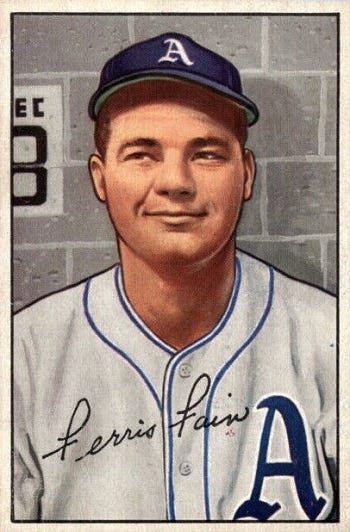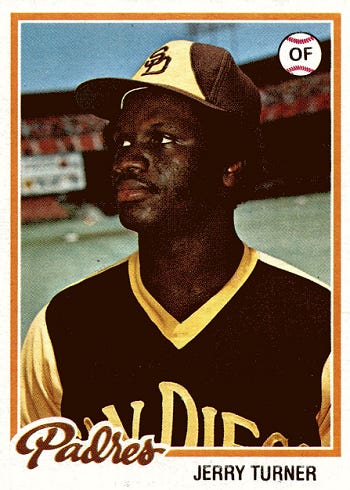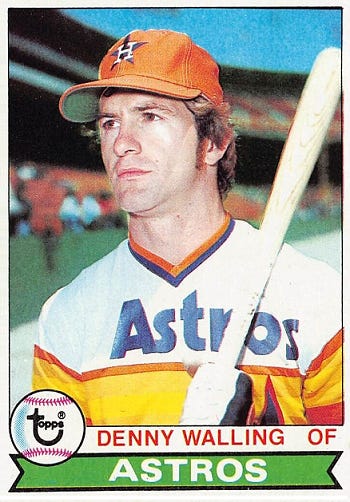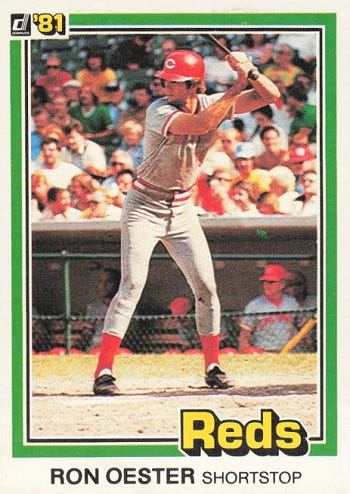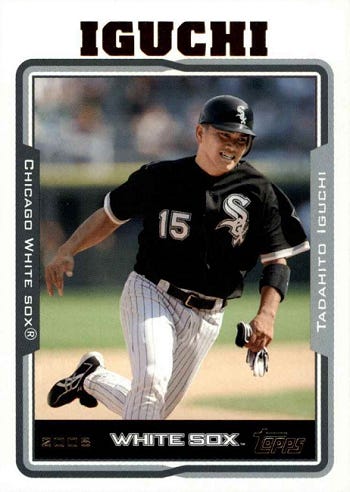The first Reds second baseman I ever knew about, Ron Oester, turns 68 years old today. When his name popped up in the list of baseball birthdays, I of course had to study his stats a bit more closely.
By this point, I have a pretty good handle on who Oester was as a player — solid glovework, middling batting average, light on the power (except 1983), enough speed to steal a few and pull out some triples, too many strikeouts for a middle infielder.
But something jumped out at me this time when I was looking at Oester’s career line…he hit 42 home runs and stole 40 bases over his 13 seasons with the Reds.
That’s right.
Ron Oester was a 40-40 man, just like Jose Canseco! Not only that, Oester’s 42-40 matches The Chemist’s celebrated 1988 totals exactly.
That got me wondering…are there other 40-40 career men, players who finished with between 40 and 49 home runs and stolen bases.
There are, indeed!
Here are five of those power/speed demons, along with their first solo baseball card so you can get a good look at their greatness.
1952 Bowman Ferris Fain (#154)
OK, I’m breaking the rules right up front with the 1951-52 American League batting champ, because Fain’s first solo card was a 1949 Bowman. It’s fairly historic but also pretty strange.
This 1952 Bowman gem, on the other hand, is — well — a gem. Fain looks pretty darn cheeky in his picture, for one thing, which fits our premise here pretty well. And maybe with some of his extracurricular activities (not hard to find if you search a bit).
As for his place in our 40-40 club, Fain clubbed 48 homers and swiped 46 stolen bases during his nine-year big league career. Those may seem like modest totals, but he built his fame, as it were, on hitting for average and drawing walks — a career .290 BA and .424 OBP.
1978 Topps Jerry Turner (#364)
Turner looks downright thrilled to be included on this list, but that’s the price of success and fame — gotta deal with plebes like me sometimes.
It took Turner awhile to get his feet under him in the majors and break free of multiplayer rookie cards, but he finally made it after a 10-homer, 12-steal season for the Padres in 1977.
Overall, Turner played in the bigs from 1974 through 1983, with nine of those seasons spent at least partially in mustard. He also played part of 1981 for the White Sox, then headed to Detroit in 1982 before finishing back “home” with the Padres for his final season.
If you like symmetry in your career 40-40 men, Turner is your man: 45 home runs, 45 steals.
1979 Topps Denny Walling (#553)
Everybody looks better in the Astros rainbow from the 1970s and 1980s, right? I mean, unless you have the choice to put them in a Reds uniform, like Cesar Cedeño.
That makes it hard to be objective about Denny Walling’s 1979 Topps card, what with those surface-of-the-sun duds on full display. Certainly, it’s cheerier look than the tiny shot of Walling in dreary A’s garb that we got on his 1977 Topps rookie card.
But Walling was a pretty darn good player in his own right, something of a supersub. To wit, Walling played in 1271 games during his 18-year career and started only 663 of them, but he appeared in 100+ games at each of first base, third base, left field, and right field, and he also had 456 pinch-hit appearances.
All told, Walling hit a respectable .271 with 49 home runs and 44 stolen bases after traveling maybe the most circuitous route to our 40-40 promised land among any of its illustrious inhabitants.
1981 Donruss Ron Oester (#423)
Oester appeared on one of those black-and-white, three-player rookie cards in the 1979 Topps set, between Mike LaCoss and Harry Spilman. After he appeared in just six games in the big leagues that summer, Topps left him out of their 1980 set.
Oester was back in cardboard in 1981 after finishing fourth in National League Rookie of the Year voting in 1980, so we had our pick here. All three were a bit boring, but this Donruss number at least has some interesting background noise. Plus, 1981 Donruss hardly ever gets any play, so here we are.
I’m still sort of miffed that Oester never got to be Reds manager — probably should have happened in 1995 after they fired (!) Davey Johnson, but the gig went to Ray Knight. What the…
The Reds did offer the job to Oester in 2001…sort of. It turned out to be a lowball deal, making the whole thing feel more like an empty gesture made out of some sense of obligation rather than a legitimate hiring attempt.
Number 16 declined.
I’m betting GM Jim Bowden didn’t realize the 40-40 glory he was messing with at the time.
2005 Topps Updates & Highlights Tadahito Iguchi (#UH66)
From a rate perspective, Iguchi is head and shoulders above the rest of the guys on this list.
That’s because he spent the first eight years of his pro career slugging and running for the Fukuoka Daiei Hawks in Japan, topping out at 30 HR and 42 SB in 2001. Big season after big season turned American teams into piranhas, and the White Sox led the feeding frenzy.
Signed for the 2005 season, Iguchi paid immediate dividends as the new second baseman on the southside. He hit .278 with 15 home runs and 15 stolen bases, then that fall became the first Japanese-born player to win a World Series.
But Iguchi was already 30 by that time, and he only stayed in MLB for four seasons. He made the most of his time, though, batting .268 with 44 homers and 48 steals.
This list benefits from his return to Japan because Iguchi played another nine years before moving into coaching. Pretty sure he would have played himself out of our 40-40 club had any of those years been spent in America.
—
There are a few other players who qualify for this version of 40-40 if you care to dig into them a bit. Some others will probably enter the realm as current players wrap up their careers, but some other others will probably get to feeling a little cocky and crash into 50-40 or 40-50 territory.
Heck, some might even go 50-50.
The good news is, someday, some fan or collector or armchair stats guy will realize what those players have done and tag some baseball cards and rambling words to the whole shebang.
Might even be me.
Thanks for reading.
—Adam




